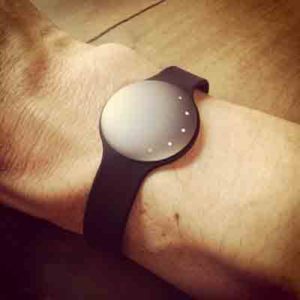Click here for the original InShape News article.
Fitbit®, Garmin, Apple Watch, Misfit, Jawbone®, Smartwatch?
About 20% of us are using personal fitness trackers – so what’s the skinny on these mini devices?

What is a personal fitness tracker?
A personal fitness tracker, sometimes also called a smart band, is generally a wrist-worn electronic device that contains a watch as well as various tracking sensors to measure exercise metrics such as your steps, flights of stairs, exercise sessions, calories burned, heart rate and even your sleep patterns.
How do personal fitness trackers work?
In simple terms wrist-worn devices all measure motion with the use of 3-axis accelerometer (measuring movement in each direction) and sometimes a gyroscope that measures rotation. This data is then fed into custom-written software (depending on the brand of device) that analyses and converts, to the best of its ability, the data into more meaningful statistics like steps, distance, calories and stairs climbed.
Devices that monitor heart rate also include an optical sensor (aka ‘the green light’) that shines to illuminate the capillaries under your skin, measuring the rate at which your blood is being pumped through.
Similarly sleep patterns are measured using an actimetry sensor which essentially measures wrist movement, sometimes combined with other sensor inputs, and analyses it to determine your wake, sleep and restless periods.
Some trackers (especially those designed for long distance sports like running) also have a GPS to track your actual position on the planet via satellites (much like sat Nav for your car). Others include galvanic skin response sensors to measure sweat, thermometers to measure temperature and ambient or UV light sensors or bioimpedance sensors to gain input data for analysis.
To check what’s in an individual brand check out the following Wearable and Digital Trends articles to see how various fitness trackers work.
The skinny: Various sensors in the fitness tracker provide raw user data that is then interpreted by software (that uses basic assumptions and calculations) into more meaningful data.
Are personal fitness trackers accurate?
Yes, and no. Personal trackers use varying technology to gain and analyse user data but all rely on user inputs including weight, stride length, wrist dominance and sometimes height and age to provide more precise reporting. So if you don’t change the default factory settings your readings may be incorrect.
One University of Pennsylvania study found the step count on fitness trackers could be as much as 22% out when compared with old-style pedometers and accelerometers. But the University of North Carolina’s Professor Kelly Evenson says lab and field tests revealed trackers were reasonably accurate, but tended to overestimate distance with slow speeds, and underestimate when moving fast.
In a test of 10 fitness trackers, CBNC’s Eric Chemi reported all devices were close to reporting accurately but each device did vary slightly. Fitbit® Charge HR (which also records sleep patterns) was the most accurate when it came to step counts; Apple Watch for heart rate; and Withings Pulse O2 for distance. But most of these devices record additional activities that were not subject to testing.
What is most useful about any fitness tracker is the daily comparison of results by the same user. Just like any gym routine or fitness program you’re only in competition with yourself and your results are the only ones that matter (despite many trackers having the ability to join virtual groups and compete in weekly competitions). Personal fitness trackers are a way of setting targets, and tracking and recording your gradual improvement, or the lack thereof.
And most reports like The Guardian’s Amy Fleming and Shape’s Paige Fowler tend to agree: it’s about the user being able to monitor their own data, even if it’s just feedback or a guide to make incremental improvements.
The skinny? All fitness trackers vary in results slightly.
What are the best personal fitness trackers?
Right now the best fitness tracker, according to TechRadar, is the Fitbit® Charge 2 which connects with the GPS on your phone, particularly good for joggers and runners. Second is Samsung’s Gear Fit 2, third is Microsoft’s Band 2 and fourth is the Fitbit® Flex 2. However the TechRadar report excluded Smart Watches which are reported separately here.
Wearable on the other hand rates Garmin’s Vivosmart HR+ the best tracker with Fitbit® Charge 2 coming in second as the best general fitness tracker. They also rated the best trackers for a range of categories including simplicity, style, parents, getting in shape, tight budget, losing weight, multisports and screen quality. Check out their full report here.
PC Magazine’s assessment put’s the Fitbit® Surge at the top of their list, with the Fitbit® Charge 2 and Garmin Forerunner 735XT runners up.
The skinny? It really depends what exercises you regularly do and what you want to track.
How do I pick the right personal fitness tracker for me?
Mens Journal quizzed fitness tracker researcher, the University of Pennsylvania’s Dr Mitesh Patel, who likened fitness trackers to a gym membership – the novelty often soon wears off. What was most important, says Dr Patel, is that wearers already had a high motivation towards improving their own health and fitness. It would seem that motivation and personal responsibility for one’s own health are huge pre-requisites when it comes to fitness trackers, but these aren’t the only factors.
The ABC’s Joel Werner and Tegan Osborne report that around 50% of people stop wearing their fitness tracker within 12 months of purchasing it. So it seems that selection of the right device for the right purpose is crucial to any device’s longevity of use.
When I asked my fitness-tracking friends what they liked about theirs the responses varied. Some liked the technological features like the Fitbit® Alta which vibrates with incoming calls, receives SMS and calendar reminders on the watch face; some wanted a tracker that looks more like a conventional watch rather than a band; others talked about the importance durability like the Garmin Vivoactive being waterproof, even in sea water (which might have been helpful for me when I fell into a French canal last year).
For me it’s the sleep tracking function of the Fitbit® Charge HR that won me over. Being able to see how many times I ‘wake’ and how many times I’m ‘restless’ and my combined sleep total for the night gives me a lot of information to proactively improve my quality of sleep.
What did seem to be a common theme was to consider the comfort and look of the unit (as you generally wear them 24 hours a day), the battery life/recharge time, ease of device use as well as the user interface (via smartphone or laptop apps).
Other friends use a non-band fitness tracker like Google Fit which uses advanced sensors in your smartphone to work out when you’re walking, jogging or cycling – good if you are a regular ‘wearer’ of your phone (probably better suited for men. Why don’t they put pockets in women’s clothing?).
Fact: there are a heap of different devices out there at a huge range of prices from the cost effective to the insane. Finding the right device is a personal choice and it may take you a few goes to find the device that’s right for you. Do your research and talk with your friends who use fitness trackers, find out what they like and dislike about their units and see if you can try theirs on. And if in doubt handy services like USA-based Lumoid provide devices for rental so you can ‘try before you buy’.
The skinny? Decide on what’s important for you, set a budget and do your research before you buy.
Tips for getting the most out of personal fitness trackers?
Once you’ve chosen your personal fitness tracker the first thing you’ll want to do is customise it. Add in your personal user settings (height, weight, stride, etc.) according to the app to ensure more accurate results.
Next, and most importantly, is to decide on what you want to track and set some goals, like hours of activity, heart rates and daily steps. If in doubt use your tracker for a week first to know what your baseline is, then set realistic goals that stretch you a little more each week.
To keep your motivation you might want to join a virtual group. Many brands have virtual groups in the apps that allow you to connect with others and share selected statistics (like step count). If a friend has the same brand of device then you may be able to create a group of your own, which is more fun and definitely more motivating. But remember, it’s your week on week results that count – you are your only competition.
If you’re on a weight loss mission many apps allow you to log your food and water. This can be time consuming but also a very sobering experience when you realise how little water and how many calories you’re actually consuming. Still it can be a very beneficial and educational exercise.
And when it comes to burning off those extra calories don’t believe everything you read (or track). Fitness trackers aren’t 100% accurate. In fact, a study from Iowa State University found that there’s more than a 15% margin of error in most trackers. Take the results as a guide and don’t get too over zealous.
If you’re prone to sitting or being inactive for long periods of time then set a regular reminder to move. Reminders and alarms are a great way to make sure you’re moving more, but they can also reduce your battery life requiring more regular recharges.
Consistency and routine are the keys when it comes to tracking. Make sure you wear your device for the same hours, or better still keep it on 24 hours a day – especially for devices that track your sleep patterns. Simply recharge your device when you’re not moving much, like sitting at your desk or when you’re in the shower. Most devices fully charge in around 20 minutes and last for 3 to 5 days.
The skinny? Personal fitness trackers can be a great way to monitor your health and wellbeing. But they require commitment, consistency and routine.


